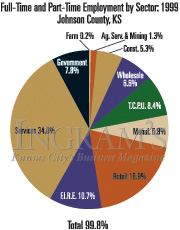Johnson County’s employment growth of 112,525 jobs from 1990 to 1999 is by far the greatest increase of any other county in the 11-county Kansas City MSA. The next closest county is Jackson with 33,647. The Johnson County labor market, as part of the larger Kansas City labor force, is also one of the most cost-effective in the country. According to a study of the nation’s 33 largest cities by the National Center for Health Statistics, workers in the Kansas City metropolitan area miss the least number of days per year due to illness. Fewer missed workdays means a more productive labor force and lower health insurance rates.

Johnson County’s work force is one of the most highly educated in the
United States, and this goes hand-in-glove with the concentration of its economy
in high-growth services-producing sectors. Each year for the two decades between
1980 and 2000, the county has added an average of 4,285 jobs in the services
sector, 935 jobs in transportation, communication and utilities (T.C.P.U.),
and 878 jobs in finance, insurance and real estate (F.I.R.E.).
As of 1999, the services sector was by far the largest wedge of the employment
pie in Johnson County, making up over a third of full-time employment. The
greatest growth from 1990 to 1999, however, was in transportation, communication
and utilities—nearly 95 percent.
Employment patterns have changed geographically as well. Just a few short
years ago, in 1990, Johnson County was a net exporter of over 5,000 workers.
The Johnson County Economic Research Institute estimates that 2000 census
data will show the county as a net importer of over 31,000 workers.

With all the new construction in Johnson
County, construction jobs increased 59 percent from 1990 to 1999.Johnson County
Transportation, Utility and Communications companies, like PageNet, have added
almost 1,000 jobs a year.
